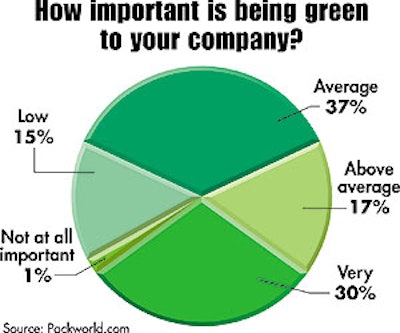Environmentally speaking, packaging all comes down to garbage, doesn’t it? The thinking is that packaging that ends up as waste is, well, wasted.
Keeping as much packaging as possible from ending up in a landfill—making it “green” or environmentally friendly—is done via the venerable three Rs: reduce, reuse, and recycle.
Packaging World took the pulse of the industry through a Web-based survey that drew 95 qualified end-user participants (see sidebar, p. 81). Like Mr. Spock’s copper-based blood, the pulse appears green tinted—and moderately strong.
Who’s interested?
Initial questions were intended to gauge how deep and widespread green packaging concepts are with manufacturers. When asked how important environmentally friendly packaging is to respondents’ companies, 30% answered “very important,” while only 1% said “not at all important” (see Chart 1).
Yet not so important that these companies have an employee who is proactive on green packaging issues—only 38% claimed their companies have such an employee. That’s not bad considering 39% of those surveyed were from small companies (1 to 100 employees). Still, should someone not wear a “green hat” part of the time at companies of any size? If for no other reason, cost savings, even under the guise of source reduction, are always a winning tactic.
The survey also aimed to discover if management at consumer packaged goods companies believed that consumers were passionate about being green. Some 47% of survey respondents indicated that consumers had an “average” interest (see Chart 2). Only 5% feel consumers have “no interest.”
Taking that notion a step further, we asked: Would consumers pay a premium for “greenness”? Expectedly, a majority, 61%, said “No.” Surprisingly, 29% said a 1 to 2.9% premium was possible. More surprisingly, roughly 10% believed consumers would pay 3% or more for green packaging.
Got green?
Packagers were asked to note what environmentally friendly advances their company has made over the past five years. Only a fraction, 15%, reported no progress. The reported improvements split neatly and nearly uniformly at about 25% for each for the three options we offered: use of recycled materials; recyclable packaging; and source reduction. Some 7% said “other changes.”
When asked how their company identifies environmentally friendly packaging (see Chart 3), 29% claimed to use recycled paperboard coding, and 15% use some sort of proprietary logo.
Some 40% said their company had considered using biodegradable packaging (see Chart 4). Commercial examples, though, remain scarce (see packworld.com/go/c002). One respondent, in quality assurance for a chemical company, urged suppliers to “develop a plastic bottle that is easily biodegradable.”
He was one of dozens who were moved to provide their viewpoints, some of which appear in separate coverage on the PW Web site. In fact, more than half who took the survey offered their input. Out of the many issues, thoughts, asides, and personal comments that were expressed via this freewheeling format, two distinct issues emerged as common ground: economics and education.
A dozen respondents commented that cost-effective materials were crucial for environmental efforts. One production manager from a small food company in the East suggested “finding ways to make products more price competitive with existing packaging.” Several qualified that with the admonition that the quality must also be good. “Suppliers can continue to develop new technologies that allow recycled materials to become competitive in cost,” noted an engineer at a medium sized cosmetics and personal care firm in the Northeast. Another, involved in packaging of cosmetics at a large company, wanted suppliers to “present manufacturing solutions, not just offer new materials.”
Get smarter
A dozen of those surveyed also pointed to the importance of education, proper marketing, and related issues. “Stay current on consumer trends and look for opportunities to reduce packaging,” reported a packager at a large, nonfood consumer products company. “Offer education to explain just what environmentally friendly is,” advises another. For details on one methodology to determine greenness, see the sidebar p. 78.
Self-education is another helpful strategy, offered an engineer at a large nonfood consumer products company: “Stay at the forefront of environmental issues.” “Share research information,” added an engineer at a very large Midwest brewery.
For their part in education, suppliers can “identify packaging materials alternatives and organize and sponsor recycling efforts,” suggested an engineer from a large medical and pharmaceutical plant in the western United States.
One company that has long been at the forefront of environmental packaging issues is Hewlett-Packard, Palo Alto, CA. Corporate packaging engineer Tim Lalley says for years H-P has had an “environmental task force” staffed with engineers such as himself that meets monthly. “We discuss new policies, how to improve our policies, and then get that information disseminated to the various divisions,” he explains. The company is proactive on keeping up with environmental developments globally. According to Lalley, “Throughout the world, we have ‘environmental stewards’ who keep us informed of regional developments in environmental policies.” He discloses rumblings that “some of the Asian countries may be taking on [the stringent] European-type policies.” A global perspective compels companies such as H-P to stay ahead of the pack, environmentally speaking.
Several of those surveyed provided cautionary notes regarding certain materials.
One respondent, from a nonfood consumer products company in the Northeast, offered this broad-stroke advice: “Try to stay away from plastics.”
A packaging manager at a very large industrial products company in the West was somewhat less universally condemning of plastics, but suggests: “Avoid any non-PET or non-HDPE plastics that curbside pickups refuse.” He also suggested that packagers “make [packaging] materials easy to separate” for curbside recycling.
Another noted that his company, a medium-sized cosmetics and personal care firm in the Northeast, has discontinued using polyvinyl chloride. A packaging manager reporting from a multinational company’s northeastern U.S. location, was more “graphic” in his warning: “Phase out ... fluorocarbons, and reduce residual solvents and heavy metals in inks.”
Just as they always have, time and consumers remain the best judges.
“Environmental issues are not something a lot of [companies] spend a lot of resources on, but it’s becoming increasingly important, including in the minds of consumers,” opines Lalley. “I think this is something we can all do a better job on.”
As for packagers who want to get or stay enlightened in a green way, here are two pieces of advice offered by participants:
“Take the initiative to reduce, reuse, and recycle before regulations force you into it through laws and fees!” Urged another: “Get on board now!” However, PW’s regulatory columnist, Stephen Barlas, states that he hasn’t come across any green packaging- or recycling-related legislation for a number of years.
Based on the responses, it seems that those who participated had a green bent, and so they may be ahead of the curve when it comes to green issues, too. A full 86% of respondents believed that concern about packaging’s impact on the environment will grow (see Chart 5). That’s a high percentage which perhaps portends a trend that bears watching.
For highlights of individual survey responses, see: packworld.com/go/w004
See sidebar to this article: Exactly how green is that package?
See sidebar to this article: Who participated in the survey


























